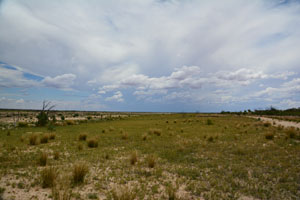Lake Bindegolly National Park
 Lake Bindegolly National Park is located approximately 34km east of Thargomindah and due to the fragile nature of the area access is only on foot.
Lake Bindegolly National Park is located approximately 34km east of Thargomindah and due to the fragile nature of the area access is only on foot.
A string of separate lakes - Hutchinson, Toomaroo and Lake Bindegolly - join to form a vast ribbon of water after heavy rain.
More than just lakes, 14 000 ha Lake Bindegolly National Park was gazetted in 1991 to protect the rare tree Acacia ammophila that grows along nearby sand dunes.
This diverse park also contains samphire flats, claypans, sand dunes, hard and soft red mulga country, gidgee woodlands and Eremophila shrublands.
When water arrives in the lakes, so do the birds. Red-necked avocets, pied stilts, pink-eared ducks, grey teal and hard head ducks are usually the first waterbirds to arrive.
Waterbirds are attracted by the diverse invertebrates such as shrimps, yabbies and insects, which explode in numbers, and the fish and aquatic plants that develop. These birds are followed by spoonbills, cormorants, black swans, terns, gulls, coots, grebes, and even more ducks including the ‘near threatened' freckled duck. Most of these birds usually stay on through to the final stages of the lakes' drying-up with the fish-eating birds the first to leave.
Finding Bindegolly
Just off the sealed Bulloo Developmental Road (Adventure Way) 150 km west of Cunnamulla, 40 km east of Thargomindah.
Camping is not permitted at Lake Bindegolly National Park, however, bush camping is available nearby.
Walking: Lake Bindegolly circuit 9.2 km, 3 hrs return
Skirt the eastern edge of Lake Bindegolly to return via low, grass-covered sandhills. Stop to look for waterbirds at an observation point located at the edge of the lake. Note: sections of the walking track may be covered by water when the lake is full.
Please stay on the track. Although able to withstand high salt levels and long periods both in and out of water, samphire (salt-tolerant) plants are easily destroyed by trampling. Samphire plants trap sediments and nutrients and help stabilise the lakes' edges.
